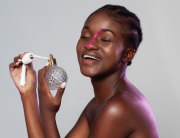Natural hair is a beautiful expression of heritage, identity, and strength. But while coils, kinks, and curls get plenty of attention, the true foundation of healthy hair often gets neglected—the scalp. A nourished, balanced scalp is the key to stronger strands, consistent growth, and long-term hair health. It’s time to shift the focus from just styling to sustaining the scalp—because your crown is only as strong as its foundation.
Why Scalp Health Matters
Think of your scalp like soil in a garden. If the soil is dry, imbalanced, or full of buildup, it’s nearly impossible for plants to grow. The same applies to your hair. Your scalp houses the follicles from which your hair grows, and these follicles need a clean, hydrated, and nourished environment to thrive.
Neglecting scalp health can lead to issues like:
-
Itchiness and dryness
-
Flaking or dandruff
-
Inflammation or tenderness
-
Stunted hair growth
-
Hair thinning or shedding
Common Scalp Challenges in the Natural Hair Community
-
Product Buildup
Many natural hair products are thick, oil-based, or contain heavy butters. While they can lock in moisture, overuse can clog follicles and suffocate the scalp. -
Dryness
Scalp dryness is common due to the tight curl pattern of natural hair, which makes it harder for natural oils (sebum) to travel down the hair shaft. The result? A flaky, tight-feeling scalp that’s crying out for moisture. -
Overwashing or Underwashing
Some naturals overwash out of fear of buildup, while others underwash to preserve moisture. Both extremes can lead to imbalance—either stripping away essential oils or leaving behind residue that irritates the skin. -
Tension and Protective Styles
Protective styles like braids, wigs, and weaves are wonderful, but when done too tightly or left in too long, they can damage the scalp and lead to traction alopecia (hair loss from stress on the follicles).
Steps to a Healthier Scalp
Here’s how to maintain a healthy, thriving scalp beneath your crown:
1. Cleanse Regularly but Gently
Use a sulfate-free shampoo or a gentle cleanser that can remove buildup without stripping your scalp’s natural oils. Depending on your lifestyle and product use, washing every 1–2 weeks works for most naturals.
2. Exfoliate Your Scalp
Just like your skin, your scalp benefits from gentle exfoliation. Use a scalp scrub or a soft scalp brush once a month to remove dead skin cells and stimulate blood flow.
3. Hydrate and Moisturize
Use lightweight oils like jojoba, tea tree, or peppermint oil to hydrate and soothe the scalp. These oils can reduce inflammation and promote circulation without clogging pores.
4. Protect Your Scalp from the Elements
The sun, cold air, and even indoor heating can dry out your scalp. Use a silk or satin scarf at night and consider protective styles that aren’t too tight to help shield your scalp.
5. Listen to Your Scalp
Itching, flaking, or tenderness isn’t “normal”—it’s your scalp’s way of asking for help. Don’t ignore these signs. If you’re dealing with persistent issues, consult a dermatologist or trichologist.
Natural Scalp-Loving Ingredients to Look For
-
Aloe Vera – Soothes irritation and hydrates
-
Tea Tree Oil – Antifungal and antibacterial properties
-
Peppermint Oil – Stimulates circulation and refreshes
-
Apple Cider Vinegar – Balances pH and removes buildup
-
Witch Hazel – Reduces inflammation and oiliness
Your Hair Thrives When the Scalp is Alive
Beautiful hair starts at the root—literally. When you give your scalp the attention it deserves, your natural hair will respond with strength, shine, and growth. Remember, your crown isn’t just your hair—it’s the healthy foundation beneath it too.







Add Comment
You must be logged in to post a comment.